2008 Seat Ibiza 5D engine oil capacity
[x] Cancel search: engine oil capacityPage 155 of 260
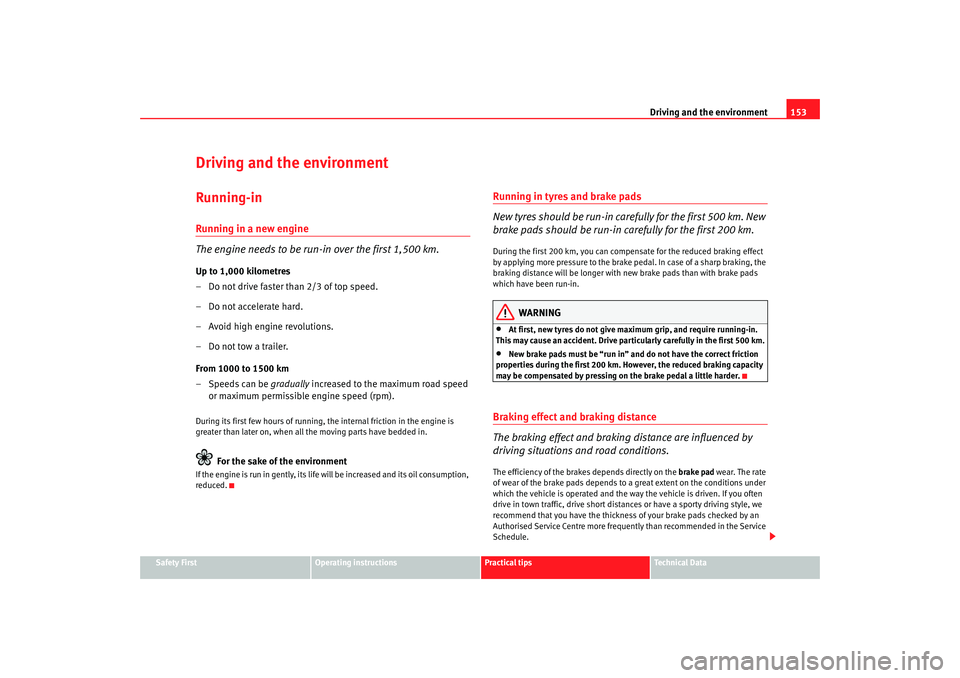
Driving and the environment153
Safety First
Operating instructions
Practical tips
Te c h n i c a l D a t a
Driving and the environmentRunning-inRunning in a new engine
The engine needs to be run-in over the first 1,500 km.Up to 1,000 kilometres
– Do not drive faster than 2/3 of top speed.
– Do not accelerate hard.
– Avoid high engine revolutions.
– Do not tow a trailer.
From 1000 to 1500 km
–Speeds can be gradually increased to the maximum road speed
or maximum permissible engine speed (rpm).During its first few hours of running, the internal fric tion in the engine is
greater than later on, when all the moving parts have bedded in.
For the sake of the environment
If the engine is run in gent ly, its life will be increased and its oil consumption,
reduced.
Running in tyres and brake pads
New tyres should be run-in carefully for the first 500 km. New
brake pads should be run-in carefully for the first 200 km.During the first 200 km, you can compensate for the reduced braking effect
by applying more pressure to the brake pedal. In case of a sharp braking, the
braking distance will be longer with new brake pads than with brake pads
which have been run-in.
WARNING
•
At first, new tyres do not give maximum grip, and require running-in.
This may cause an accident. Drive particularly carefully in the first 500 km.
•
New brake pads must be “run in” and do not have the correct friction
properties during the first 200 km. However, the reduced braking capacity
may be compensated by pressing on the brake pedal a little harder.
Braking effect and braking distance
The braking effect and braking distance are influenced by
driving situations and road conditions.The efficiency of the brakes depends directly on the brake pad wear. The rate
of wear of the brake pads depends to a great extent on the conditions under
which the vehicle is operated and the way the vehicle is driven. If you often
drive in town traffic, drive short distances or have a sporty driving style, we
recommend that you have the thickness of your brake pads checked by an
Authorised Service Centre more freque ntly than recommended in the Service
Schedule.
Ibiza250_angles Seite 153 Dienstag, 5. August 2008 1:11 13
Page 156 of 260
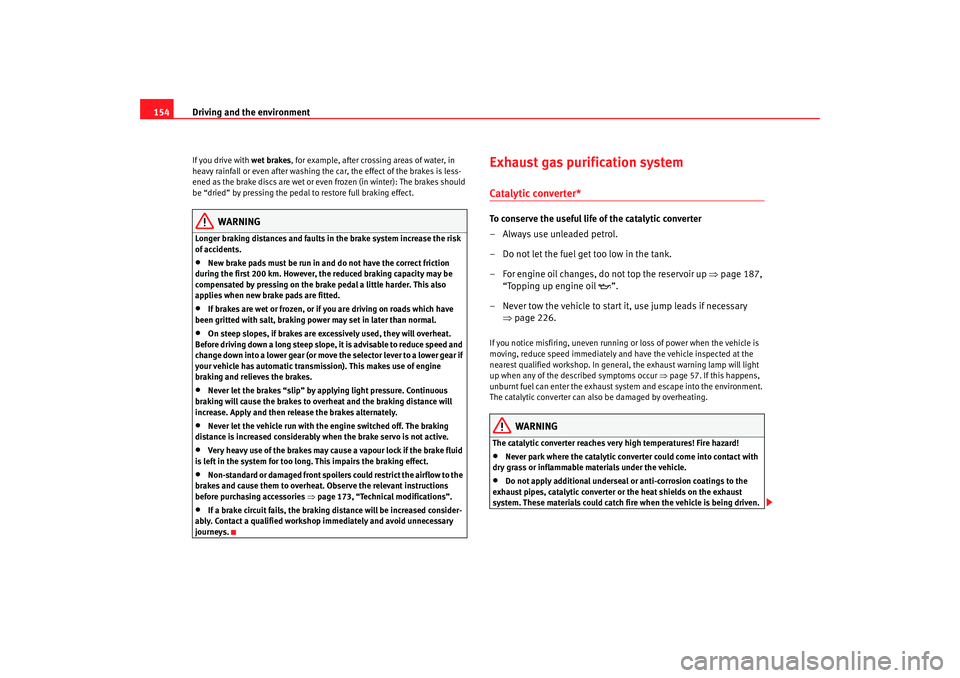
Driving and the environment
154If you drive with wet brakes, for example, after crossing areas of water, in
heavy rainfall or even after washing the car, the effect of the brakes is less-
ened as the brake discs are wet or even frozen (in winter): The brakes should
be “dried” by pressing the pedal to restore full braking effect.
WARNING
Longer braking distances and faults in the brake system increase the risk
of accidents.•
New brake pads must be run in and do not have the correct friction
during the first 200 km. However, the reduced braking capacity may be
compensated by pressing on the brake pedal a little harder. This also
applies when new brake pads are fitted.
•
If brakes are wet or frozen, or if you are driving on roads which have
been gritted with salt, braking power may set in later than normal.
•
On steep slopes, if brakes are excessively used, they will overheat.
Before driving down a long steep slope, it is advisable to reduce speed and
change down into a lower gear (or move the selector lever to a lower gear if
your vehicle has automatic transmission). This makes use of engine
braking and relieves the brakes.
•
Never let the brakes “slip” by applying light pressure. Continuous
braking will cause the brakes to overheat and the braking distance will
increase. Apply and then release the brakes alternately.
•
Never let the vehicle run with the engine switched off. The braking
distance is increased considerably when the brake servo is not active.
•
Very heavy use of the brakes may cause a vapour lock if the brake fluid
is left in the system for too long. This impairs the braking effect.
•
Non-standard or damaged front spoilers could restrict the airflow to the
brakes and cause them to overheat. Observe the relevant instructions
before purchasing accessories ⇒ page 173, “Technical modifications”.
•
If a brake circuit fails, the braking distance will be increased consider-
ably. Contact a qualified workshop immediately and avoid unnecessary
journeys.
Exhaust gas purification systemCatalytic converter*To conserve the useful life of the catalytic converter
– Always use unleaded petrol.
– Do not let the fuel get too low in the tank.
– For engine oil changes, do not top the reservoir up ⇒page 187,
“Topping up engine oil ”.
– Never tow the vehicle to start it, use jump leads if necessary ⇒page 226.If you notice misfiring, uneven running or loss of power when the vehicle is
moving, reduce speed immediately and have the vehicle inspected at the
nearest qualified workshop. In general, the exhaust warning lamp will light
up when any of the described symptoms occur ⇒page 57. If this happens,
unburnt fuel can enter the exhaust system and escape into the environment.
The catalytic converter can also be damaged by overheating.
WARNING
The catalytic converter reaches very high temperatures! Fire hazard!•
Never park where the catalytic convert er could come into contact with
dry grass or inflammable materials under the vehicle.
•
Do not apply additional underseal or anti-corrosion coatings to the
exhaust pipes, catalytic converter or the heat shields on the exhaust
system. These materials could catch fire when the vehicle is being driven.
Ibiza250_angles Seite 154 Dienstag, 5. August 2008 1:11 13
Page 242 of 260
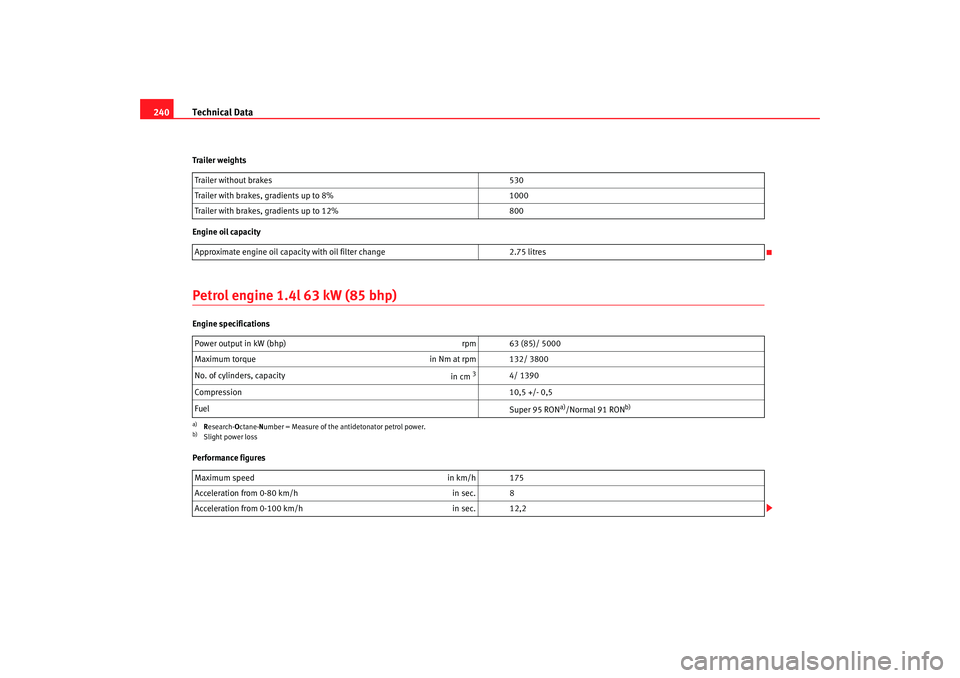
Technical Data
240Trailer weights
Engine oil capacityPetrol engine 1.4l 63 kW (85 bhp)Engine specifications
Performance figures Trailer without brakes
530
Trailer with brakes, gradients up to 8% 1000
Trailer with brakes, gradients up to 12% 800
Approximate engine oil capacity with oil filter change 2.75 litres
Power output in kW (bhp) rpm 63 (85)/ 5000
Maximum torque in Nm at rpm 132/ 3800
No. of cylinders, capacity in cm
3
4/ 1390
Compression 10,5 +/- 0,5
Fuel Super 95 RON
a)/Normal 91 RON
b)
a)Research- Octane- Number = Measure of the antidetonator petrol power.b)Slight power lossMaximum speed in km/h 175
Acceleration from 0-80 km/h in sec. 8
Acceleration from 0-100 km/h in sec. 12,2
Ibiza250_angles Seite 240 Dienstag, 5. August 2008 1:11 13
Page 243 of 260
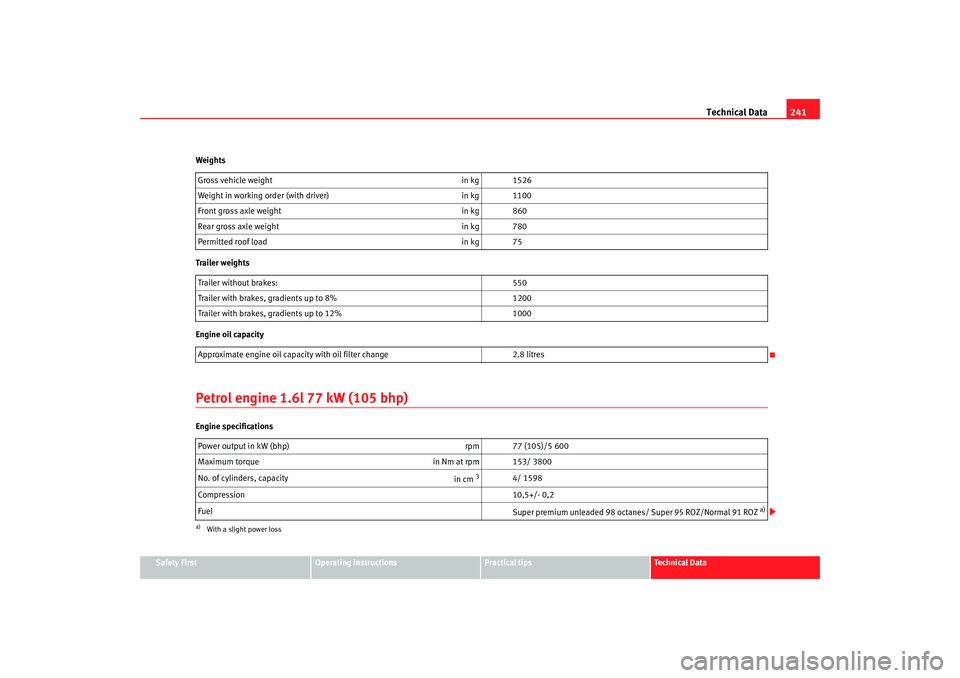
Technical Data241
Safety First
Operating instructions
Practical tips
Te c h n i c a l D a t a
Weights
Trailer weights
Engine oil capacity
Petrol engine 1.6l 77 kW (105 bhp)Engine specifications
Gross vehicle weight
in kg 1526
Weight in working order (with driver) in kg 1100
Front gross axle weight in kg 860
Rear gross axle weight in kg 780
Permitted roof load in kg 75
Trailer without brakes: 550
Trailer with brakes, gradients up to 8% 1200
Trailer with brakes, gradients up to 12% 1000
Approximate engine oil capacity with oil filter change 2.8 litres
Power output in kW (bhp) rpm 77 (105)/5 600
Maximum torque in Nm at rpm 153/ 3800
No. of cylinders, capacity in cm
3
4/ 1598
Compression 10,5+/- 0,2
Fuel Super premium unleaded 98 octanes/ Super 95 ROZ/Normal 91 ROZ
a)
a)With a slight power loss
Ibiza250_angles Seite 241 Dienstag, 5. August 2008 1:11 13
Page 244 of 260
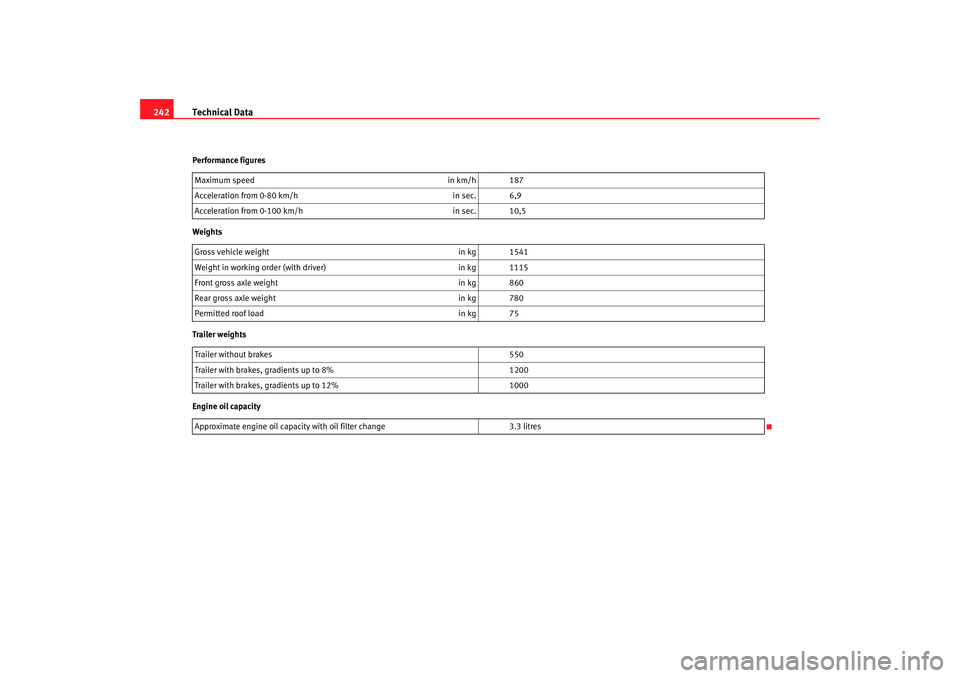
Technical Data
242Performance figures
Weights
Trailer weights
Engine oil capacity Maximum speed
in km/h 187
Acceleration from 0-80 km/h in sec. 6,9
Acceleration from 0-100 km/h in sec. 10,5
Gross vehicle weight in kg 1541
Weight in working order (with driver) in kg 1115
Front gross axle weight in kg 860
Rear gross axle weight in kg 780
Permitted roof load in kg 75
Trailer without brakes 550
Trailer with brakes, gradients up to 8% 1200
Trailer with brakes, gradients up to 12% 1000
Approximate engine oil capacity with oil filter change 3.3 litres
Ibiza250_angles Seite 242 Dienstag, 5. August 2008 1:11 13
Page 246 of 260
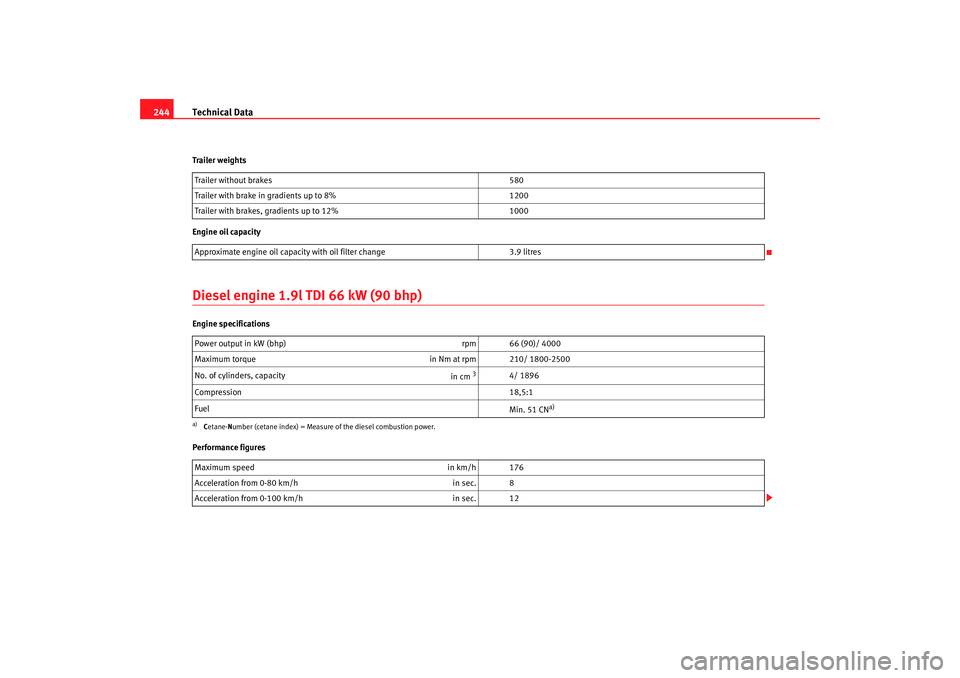
Technical Data
244Trailer weights
Engine oil capacityDiesel engine 1.9l TDI 66 kW (90 bhp)Engine specifications
Performance figures Trailer without brakes
580
Trailer with brake in gradients up to 8% 1200
Trailer with brakes, gradients up to 12% 1000
Approximate engine oil capacity with oil filter change 3.9 litres
Power output in kW (bhp) rpm 66 (90)/ 4000
Maximum torque in Nm at rpm 210/ 1800-2500
No. of cylinders, capacity in cm
3
4/ 1896
Compression 18,5:1
Fuel Min. 51 CN
a)
a)Cetane- Number (cetane index) = Measure of the diesel combustion power.Maximum speed in km/h 176
Acceleration from 0-80 km/h in sec. 8
Acceleration from 0-100 km/h in sec. 12
Ibiza250_angles Seite 244 Dienstag, 5. August 2008 1:11 13
Page 247 of 260

Technical Data245
Safety First
Operating instructions
Practical tips
Te c h n i c a l D a t a
Weights
Trailer weights
Engine oil capacity
Diesel engine 1.9l TDI 77 kW (105 bhp)Engine specifications
Gross vehicle weight
in kg 1626
Weight in working order (with driver) in kg 1200
Front gross axle weight in kg 940
Rear gross axle weight in kg 780
Permitted roof load in kg 75
Trailer without brakes 600
Trailer with brakes, gradients up to 8% 1200
Trailer with brakes, gradients up to 12% 1200
Approximate engine oil capacity with oil filter change 4 litres
Power output in kW (bhp) rpm 77 (105)/ 4000
Maximum torque in Nm at rpm 240/ 1900
No. of cylinders, capacity in cm
3
4/ 1896
Compression 18,5
Fuel Min. 51 CN
a)
a)Cetane- Number (cetane index) = Measure of the diesel combustion power.
Ibiza250_angles Seite 245 Dienstag, 5. August 2008 1:11 13
Page 248 of 260
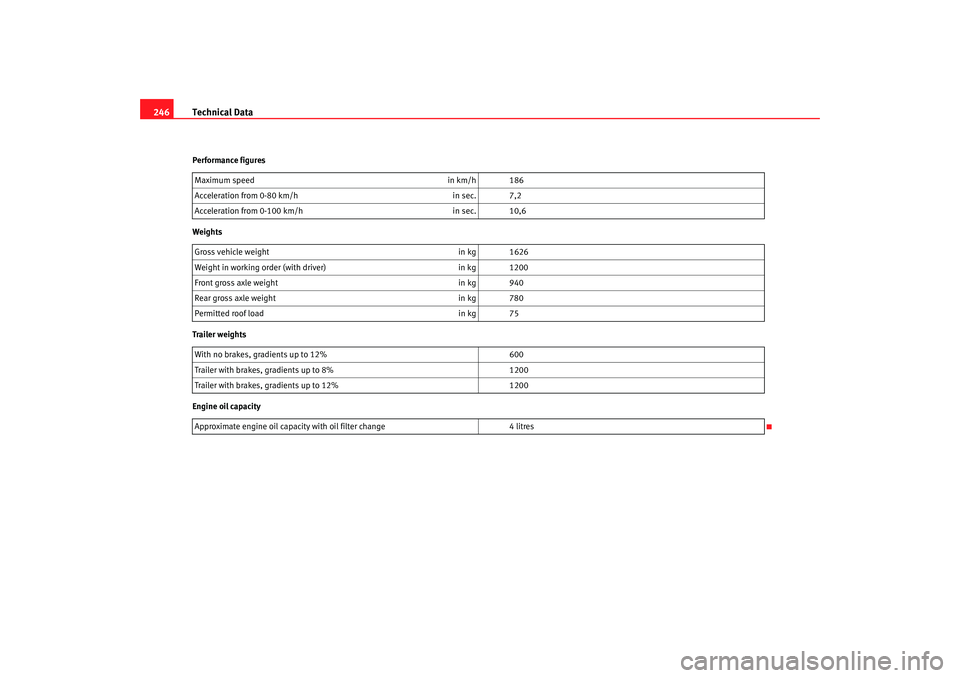
Technical Data
246Performance figures
Weights
Trailer weights
Engine oil capacity Maximum speed
in km/h 186
Acceleration from 0-80 km/h in sec. 7,2
Acceleration from 0-100 km/h in sec. 10,6
Gross vehicle weight in kg 1626
Weight in working order (with driver) in kg 1200
Front gross axle weight in kg 940
Rear gross axle weight in kg 780
Permitted roof load in kg 75
With no brakes, gradients up to 12% 600
Trailer with brakes, gradients up to 8% 1200
Trailer with brakes, gradients up to 12% 1200
Approximate engine oil capacity with oil filter change 4 litres
Ibiza250_angles Seite 246 Dienstag, 5. August 2008 1:11 13